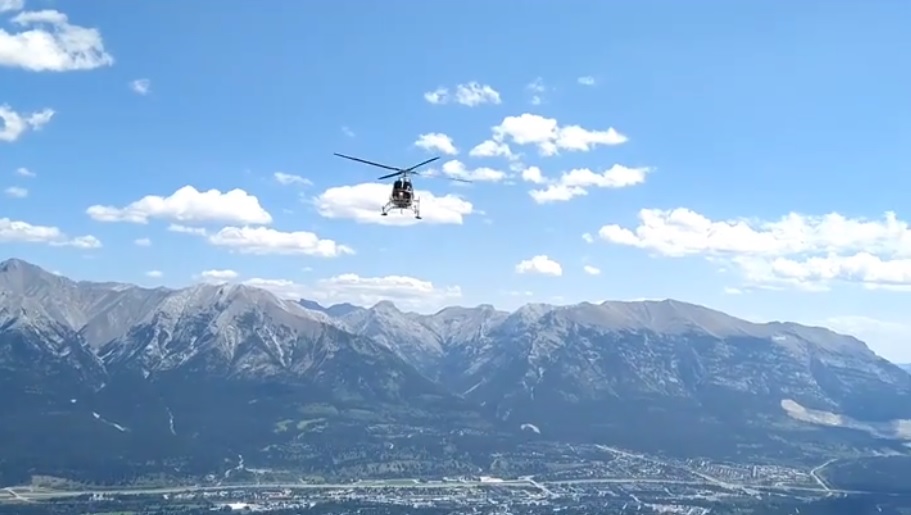Rock Climber Rescued by Helicopter on EEOR Above Canmore
The climber escaped with injuries to his hand, but it could've been much worse

On July 10, Kananaskis Country Public Safety Section performed a longline rescue of a rock climber who took a whipper on pitch-nine of Generosity 5.9 on EEOR above Canmore. There have been a number of rescues on Generosity over the years.
Below the injured party was another team of climbers, Bryan Daneau and his son. Daneau reported: If you saw the alpine chopper and K-Country Safety on EEOR today, it’s due to an unfortunate whipper by the lead climber ahead of us on pitch 9 of Generosity. Based on what we saw and info collected thereafter, it was likely a 30 m whipper with quite a few pieces of gear pulling out that happened due to a hold that broke loose as you exit the chimney on pitch-nine of Generosity. Unfortunately, the lead climber suffered a broken thumb that looked pretty nasty and hit quite a few rocks before the rope arrested him. We called in K-Country and party was heli slung out. We provided assistance as best we could until the cavalry rolled in.
The belayer of the injured climber was using a quad anchor with a quickdraw for a redirect on one of the anchor bolts. “Sometimes I unclip the redirect once the leader is quite a few pieces up, but leaving it clipped probably helped the grey Z4 catch the factor twp fall,” said Maxim Blair. “I was sitting on a small step with my clove hitch extended, so I could reach a more comfortable stance, when the rope arrested him I was thrown violently into the wall due to the redirect. I can only imagine what would have happened if that redirect wasn’t there.”
Paramedic Fabio Lacentra, an experienced rock climber, added to the report: I have climbed the route three times and knew pretty much exactly where he fell (just short of a bolt) the climber and I and his partner had a good discussion in our ambulance as my partner and I tended to his care. He was very thankful for your assistance. One thing that became apparent after the two climbers adrenaline faded away was that the belayer was also injured, potentially by the force of being thrown against the wall at the belay. This is something that has become more apparent in the last few years (especially this winter) with the discussion of direct belays, where the belay device is attached directly to a multi-directional anchor. Thus eliminating the belayer from the system. It’s something I have used more and more in the last two years. Definitely a consideration in most anchors, even gear anchors (setting a piece for upwards pull).”
Daneau mentioned a few points that he and his son discussed after the incident:
– Having a means of communicating in case of mishap is crucial – fairly easy on EEOR as you have cell phone reception.
– You just never know when a chunk of rock may decide it’s time to pull the pin and there goes your hand hold / foot hold.
– Accidents happen super fast.
– Having a minimal first aid kit is useful – especially a couple bandages (weren’t used) and Tylenol (was definitely used).
– Rescues take time – even though this one was super fast. Between the time we witnessed the whipper and everybody was back down on the ground, almost two hours had elapsed.

Direct Anchor Belay
What Lacentra mentioned in a direct anchor belay for a lead climber, which more and more climbers are learning to use. The Association of Canadian Mountain Guides (ACMG) says to consider a fixed point belay when there is/are: two very solid anchor components that can take a hard upward pull, usually two bolts or ice screws.
A fixed point belay can be done on a trad gear anchor, but you need a solid upward directional piece. It’s a good idea to learn this technique on bolts, then try it with a trad anchor. The anchor master point must be at waist to head height, chest high is ideal. This makes for easier rope feeding. If the anchor is much higher or lower (like on a slab), it can be difficult to feed rope properly.
A direct anchor belay is recommended for climbers with large weight differences, heavier leader and a lighter belayer. And when there is higher potential for a leader fall, potential for a higher impact/high fall factor, or potential for a long leader fall, such as slab routes or alpine ice routes. Below is a 2017 tutorial video by Ecole Nationale de Ski et d’Alpinisme about different belay methods.


